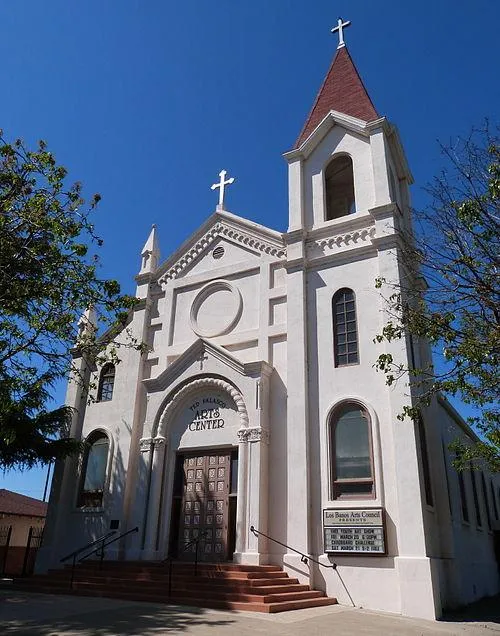Blog > Article Library
North Point Building & Design - Article Library
Welcome to North Point Building and Design's Article Library, where expertise meets inspiration. Explore a curated collection of insightful articles that delve into the art and science of creating dream spaces. From the intricacies of crafting custom homes that reflect your unique style to the transformative journey of home additions that enhance functionality, and the fine art of kitchen remodels that breathe new life into your living spaces—our library is a treasure trove of knowledge, guiding you through every facet of turning your vision into reality. Join us on this journey of discovery, where each article is a step closer to realizing the home you've always imagined.

Articles

History of Los Banos, CA
History of Los Banos, CA
Early Inhabitants and Spanish Exploration
Los Banos, California, boasts a history as diverse and colorful as the landscape that surrounds it. Long before the arrival of European settlers, the area was home to Native American tribes, including the Yokuts and Miwok. These indigenous communities thrived along the banks of the San Joaquin River, leaving behind a legacy that would shape the city’s early history.
Spanish explorers, in the late 18th century, ventured into California, and Los Banos found itself on the path of their exploration. This marked the beginning of European influence in the region, as the Spanish established a connection with the native inhabitants.
Mexican Land Grants and Early Settlement
Mexican Land Grants
In the early 19th century, the Mexican government granted vast tracts of land, including the Los Banos area, to prominent individuals. Ranchos emerged as centers of agriculture and livestock, setting the stage for the region’s development.
Pioneer Settlement
As pioneers and prospectors ventured west during the California Gold Rush, Los Banos became a waypoint. The fertile soil and access to water made it an attractive location for settlers looking to establish farms and build communities.
Agricultural Boom and the Railroad
Agricultural Prosperity
The late 19th and early 20th centuries witnessed an agricultural boom in Los Banos. The region’s rich soil and favorable climate made it ideal for farming, with wheat, cotton, and dairy farming becoming prominent industries. This era laid the foundation for Los Banos as an agricultural hub.
The Arrival of the Railroad
The arrival of the Southern Pacific Railroad in the late 19th century was a game-changer for Los Banos. The railroad facilitated the transportation of goods and people, further accelerating the city’s growth and solidifying its position as a vital transportation nexus.
Incorporation and Community Development
A Growing Community
Los Banos officially incorporated as a city in 1907, marking a significant milestone in its development. The city continued to grow, attracting residents and businesses drawn to its agricultural opportunities and strategic location.
Turbulent Times and World War II
The Great Depression brought challenges to Los Banos, as it did to many communities across the United States. However, World War II brought a surge in economic activity, with the city’s airbase playing a role in training military personnel.
Post-War Era and Urbanization

Image Reference: https://en.wikipedia.org/wiki/Los_Banos,_California
Post-War Prosperity
Following World War II, Los Banos experienced a period of post-war prosperity. The city continued to evolve as technological advancements and irrigation projects improved agricultural practices, contributing to sustained growth.
Urbanization Challenges
As the mid-20th century progressed, Los Banos faced challenges associated with urbanization. Balancing the preservation of its agricultural heritage with the demands of a growing population became a central theme in the city’s development.
Present-Day Los Banos
Economic Diversification
Today, Los Banos stands as a diverse and dynamic city. While agriculture remains a significant part of its identity, the city has embraced economic diversification, with an emphasis on manufacturing, retail, and services.
Community Engagement and Modern Challenges
Los Banos actively engages in preserving its history through local organizations and initiatives. However, like many cities, it faces modern challenges related to infrastructure, water management, and community development.
Looking to the Future
Sustainability and Growth
As Los Banos looks toward the future, sustainability and managed growth take center stage. The city aims to balance economic expansion with environmental conservation, ensuring a vibrant and resilient community for generations to come.
Cultural Heritage Preservation
Efforts to preserve the cultural heritage of Los Banos remain ongoing, with museums, historical societies, and community events contributing to a deeper understanding and appreciation of the city’s past.
Conclusion
In conclusion, the history of Los Banos, CA, is a tapestry woven with threads of Native American heritage, Spanish exploration, agricultural prosperity, and community resilience. From its early days as a stop for pioneers on their westward journey to its present-day status as a thriving city, Los Banos continues to evolve while honoring its storied past.
Weather in Los Banos, CA
Questions and Answers about Los Banos, CA
1. Q: What is the population of Los Banos, CA?
A: As of my last knowledge update in January 2022, Los Banos had a population of approximately 40,000 residents.
2. Q: What notable attractions can be found in Los Banos?
A: Los Banos is known for attractions like San Luis Reservoir State Recreation Area, Henry Miller Plaza, and the Los Banos Wildlife Area.
3. Q: What is the climate like in Los Banos, CA?
A: Los Banos experiences a Mediterranean climate with hot, dry summers and mild, wet winters. Temperatures can often exceed 90°F during the summer months.
4. Q: Are there any annual events or festivals in Los Banos?
A: Yes, Los Banos hosts events like the Merced County Spring Fair, which showcases agricultural heritage, and the Christmas Parade, a festive community celebration.
5. Q: What is the economic base of Los Banos?
A: Agriculture plays a significant role in the local economy, with farming activities such as dairy, livestock, and crop production contributing to the city’s economic foundation.
Other Articles

Contact Us
Service Hours
Social Media
Blog >Article Library
North Point Building & Design - Article Library

Welcome to North Point Building and Design's Article Library, where expertise meets inspiration. Explore a curated collection of insightful articles that delve into the art and science of creating dream spaces. From the intricacies of crafting custom homes that reflect your unique style to the transformative journey of home additions that enhance functionality, and the fine art of kitchen remodels that breathe new life into your living spaces—our library is a treasure trove of knowledge, guiding you through every facet of turning your vision into reality. Join us on this journey of discovery, where each article is a step closer to realizing the home you've always imagined.
Articles

History of Los Banos, CA
History of Los Banos, CA
Early Inhabitants and Spanish Exploration
Los Banos, California, boasts a history as diverse and colorful as the landscape that surrounds it. Long before the arrival of European settlers, the area was home to Native American tribes, including the Yokuts and Miwok. These indigenous communities thrived along the banks of the San Joaquin River, leaving behind a legacy that would shape the city’s early history.
Spanish explorers, in the late 18th century, ventured into California, and Los Banos found itself on the path of their exploration. This marked the beginning of European influence in the region, as the Spanish established a connection with the native inhabitants.
Mexican Land Grants and Early Settlement
Mexican Land Grants
In the early 19th century, the Mexican government granted vast tracts of land, including the Los Banos area, to prominent individuals. Ranchos emerged as centers of agriculture and livestock, setting the stage for the region’s development.
Pioneer Settlement
As pioneers and prospectors ventured west during the California Gold Rush, Los Banos became a waypoint. The fertile soil and access to water made it an attractive location for settlers looking to establish farms and build communities.
Agricultural Boom and the Railroad
Agricultural Prosperity
The late 19th and early 20th centuries witnessed an agricultural boom in Los Banos. The region’s rich soil and favorable climate made it ideal for farming, with wheat, cotton, and dairy farming becoming prominent industries. This era laid the foundation for Los Banos as an agricultural hub.
The Arrival of the Railroad
The arrival of the Southern Pacific Railroad in the late 19th century was a game-changer for Los Banos. The railroad facilitated the transportation of goods and people, further accelerating the city’s growth and solidifying its position as a vital transportation nexus.
Incorporation and Community Development
A Growing Community
Los Banos officially incorporated as a city in 1907, marking a significant milestone in its development. The city continued to grow, attracting residents and businesses drawn to its agricultural opportunities and strategic location.
Turbulent Times and World War II
The Great Depression brought challenges to Los Banos, as it did to many communities across the United States. However, World War II brought a surge in economic activity, with the city’s airbase playing a role in training military personnel.
Post-War Era and Urbanization

Image Reference: https://en.wikipedia.org/wiki/Los_Banos,_California
Post-War Prosperity
Following World War II, Los Banos experienced a period of post-war prosperity. The city continued to evolve as technological advancements and irrigation projects improved agricultural practices, contributing to sustained growth.
Urbanization Challenges
As the mid-20th century progressed, Los Banos faced challenges associated with urbanization. Balancing the preservation of its agricultural heritage with the demands of a growing population became a central theme in the city’s development.
Present-Day Los Banos
Economic Diversification
Today, Los Banos stands as a diverse and dynamic city. While agriculture remains a significant part of its identity, the city has embraced economic diversification, with an emphasis on manufacturing, retail, and services.
Community Engagement and Modern Challenges
Los Banos actively engages in preserving its history through local organizations and initiatives. However, like many cities, it faces modern challenges related to infrastructure, water management, and community development.
Looking to the Future
Sustainability and Growth
As Los Banos looks toward the future, sustainability and managed growth take center stage. The city aims to balance economic expansion with environmental conservation, ensuring a vibrant and resilient community for generations to come.
Cultural Heritage Preservation
Efforts to preserve the cultural heritage of Los Banos remain ongoing, with museums, historical societies, and community events contributing to a deeper understanding and appreciation of the city’s past.
Conclusion
In conclusion, the history of Los Banos, CA, is a tapestry woven with threads of Native American heritage, Spanish exploration, agricultural prosperity, and community resilience. From its early days as a stop for pioneers on their westward journey to its present-day status as a thriving city, Los Banos continues to evolve while honoring its storied past.
Weather in Los Banos, CA
Questions and Answers about Los Banos, CA
1. Q: What is the population of Los Banos, CA?
A: As of my last knowledge update in January 2022, Los Banos had a population of approximately 40,000 residents.
2. Q: What notable attractions can be found in Los Banos?
A: Los Banos is known for attractions like San Luis Reservoir State Recreation Area, Henry Miller Plaza, and the Los Banos Wildlife Area.
3. Q: What is the climate like in Los Banos, CA?
A: Los Banos experiences a Mediterranean climate with hot, dry summers and mild, wet winters. Temperatures can often exceed 90°F during the summer months.
4. Q: Are there any annual events or festivals in Los Banos?
A: Yes, Los Banos hosts events like the Merced County Spring Fair, which showcases agricultural heritage, and the Christmas Parade, a festive community celebration.
5. Q: What is the economic base of Los Banos?
A: Agriculture plays a significant role in the local economy, with farming activities such as dairy, livestock, and crop production contributing to the city’s economic foundation.
Other Articles

Contact Us
408-840-0995
Los Banos, CA, 93635
Service Hours
Mon-Sat: 8am-6pm
Sun: Closed
Social Media





